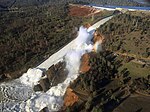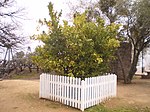Enterprise, Butte County, California
1878 establishments in California1948 disestablishments in CaliforniaButte County, California geography stubsDestroyed populated placesFormer populated places in California ... and 2 more
Former settlements in Butte County, CaliforniaSubmerged settlements in the United States
Enterprise (formerly, Mountain Spring) is a former settlement in Butte County, California. It was located 5 miles (8.0 km) west-northwest of Forbestown on the South Fork of the Feather River, at an elevation of 902 feet (275 m). In 1968, it was inundated by Lake Oroville. A post office operated at Enterprise from 1878 to 1926, with a brief closure in 1903. The town was founded in 1852 as Mountain Spring and used as a construction camp. Its later economy was based on being a supply center for the mining operations nearby, especially near Bidwell's Bar. The mining town of Yankee Flat was located 5 miles (8.0 km) southeast of Enterprise.
Excerpt from the Wikipedia article Enterprise, Butte County, California (License: CC BY-SA 3.0, Authors).Enterprise, Butte County, California
Geographical coordinates (GPS) Address Nearby Places Show on map
Geographical coordinates (GPS)
| Latitude | Longitude |
|---|---|
| N 39.536388888889 ° | E -121.36416666667 ° |
Address
Butte County (Butte)
California, United States
Open on Google Maps







